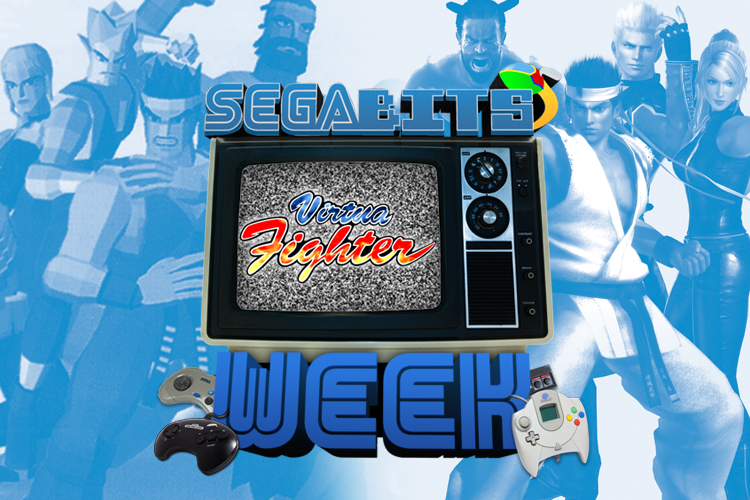
As SEGA-AM2 Month enters the final week, we thought it would be fitting to shine the spotlight on the developer’s longest running and most influential series – Virtua Fighter. One of SEGA-AM2’s defining traits is their ability to create “pure” gaming experiences. Looking at their catalog, they seem to have a penchant for taking a simple concept – be it fighting, racing, flying, or shooting – and translating it to a near-perfect 3D arcade experience. I hesitate to call SEGA-AM2’s games simulations, as gameplay is simple enough for any player and often AM2 titles have a bit of an elastic reality. Virtua Fighter didn’t have any gimmicks – there were no fatalities, weapons, adjustable bouncing breasts, or cutscenes. Players simply chose their fighter, each with their own defining style and moves, and fought. This why the term “pure” feels like the best way to describe their many games, and why the Virtua Fighter series is the purest fighting game franchise to ever exist.
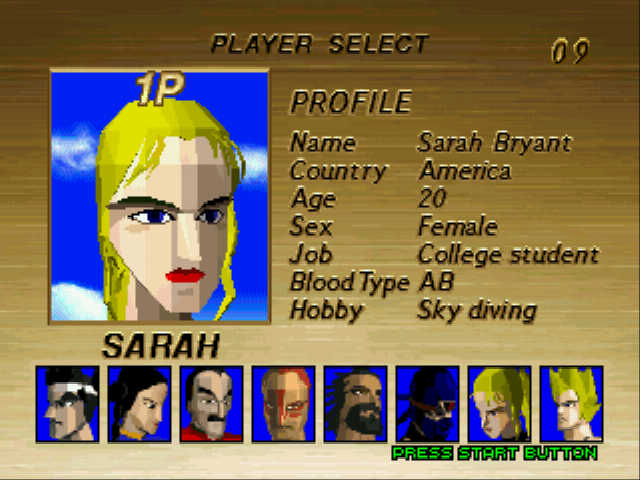
The original roster: Akira Yuki, Pai Chan, Lau Chan, Wolf Hawkfield, Jeffry McWild, Kage-Maru (“Kage”), Sarah Bryant, Jacky Bryant, and Dural (not pictured)
While not at the forefront of the game, the Virtua Fighter games do have a story and memorable characters with their own backstories. Fans could delve into Virtua Fighter lore though the manuals, strategy guides, comic books, anime episodes, and spin-off titles. But at its core, Virtua Fighter was and always has been a fighting game with deceptively simple controls. From the first game, released in 1993, through to the latest release, 2010’s Virtua Fighter 5: Final Showdown, Virtua Fighter has consisted of eight directions and buttons for guard, punch, and kick. While the series has always been a great entry-level fighter, the simplistic controls opened the door to dozens, if not hundreds, of button combinations featuring some incredibly complex moves. If there is one video game franchise that can be described as “complexity in simplicity”, Virtua Fighter is it.
Perhaps this is why Virtua Fighter, which has existed for 22 years now, has seen so few sequels despite being one of AM2’s longest running franchises. How does a game that excels in pure fighting and simplicity reinvent itself enough to warrant a sequel, let alone four sequels and numerous upgrades? Let’s find out!
The Games
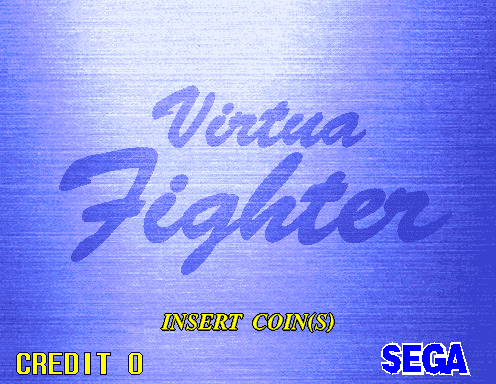 Virtua Fighter – produced and directed by arcade genius Yu Suzuki and released in November of 1993 to arcades, and to the SEGA Saturn and SEGA 32X through 1994 and 1995, this is the game that started it all – kickstarting both the franchise and the 3D fighting game genre.
Virtua Fighter – produced and directed by arcade genius Yu Suzuki and released in November of 1993 to arcades, and to the SEGA Saturn and SEGA 32X through 1994 and 1995, this is the game that started it all – kickstarting both the franchise and the 3D fighting game genre.
The game was a huge success for SEGA, particularly in Japan where arcade fighting game culture welcomed it with open arms. Those hoping for a faithful home console port, however, would have to wait as the game was simply too complex for consoles at the time. It wasn’t until late 1994 that Virtua Fighter released to home consoles as a launch title for the Saturn in Japan. The Saturn version was, however, rushed to market and has several issues including increased load times and lower quality graphics. While Japanese fans forgave these issues, Westerners who didn’t see a home console release until late 1995 found the game to not hold up as well as other 3D fighters available on home consoles at the time.
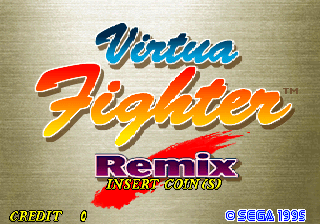 SEGA remedied this issue with the release of Virtua Fighter Remix, addressing some issues from the Saturn port and featuring textures and a higher polygon count.
SEGA remedied this issue with the release of Virtua Fighter Remix, addressing some issues from the Saturn port and featuring textures and a higher polygon count.
Remix has since been considered the de facto release of the original game, though fans of the series still pine for an unaltered, unremixed arcade-perfect release of the original game. Some fans consider the SEGA 32X port of Virtua Fighter to be the next best thing to the orignal arcade release, as it features less issues than the Saturn port.
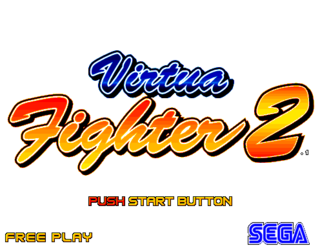 Virtua Fighter 2 is the 1994 sequel that, in this fan’s eyes, is one of the best releases from the franchise. Addressing many of the issues found in the original game whilst still maintaining old school 3D graphics, and being readily available on several home consoles with near-perfect arcade ports makes Virtua Fighter 2 a must play for any SEGA fan. Virtua Fighter 2 builds on the original by featuring faster-paced gameplay and momentum-based damage. The game also features more moves, including the ability for some characters to sidestep attacks, and adds two new characters to the original roster: Shun Di and Lion Rafale.
Virtua Fighter 2 is the 1994 sequel that, in this fan’s eyes, is one of the best releases from the franchise. Addressing many of the issues found in the original game whilst still maintaining old school 3D graphics, and being readily available on several home consoles with near-perfect arcade ports makes Virtua Fighter 2 a must play for any SEGA fan. Virtua Fighter 2 builds on the original by featuring faster-paced gameplay and momentum-based damage. The game also features more moves, including the ability for some characters to sidestep attacks, and adds two new characters to the original roster: Shun Di and Lion Rafale.
Like the original, Virtua Fighter 2 was a success for SEGA in Japan, with the sequel’s 60 frames per second high resolution graphics and gameplay improvements allowing it to stack-up with and compete against emerging competition like Namco’s Tekken. Virtua Fighter 2 saw several home ports, including the Saturn which featured additional modes and a CD soundtrack, however these features were at the expense of lower polygon counts and sacrificing 3D backgrounds. Despite this, Virtua Fighter 2 is considered one of the Saturn’s better looking games. Like Virtua Fighter Remix, the sequel saw an update by the name of Virtua Fighter 2+1. The update featured slightly altered gameplay, enhanced graphics, and the ability to play as the final boss Dural.
Virtua Fighter 2 is an important title not only for the franchise, but for several spin-offs as well, acting as a basis for Virtua Fighter Kids, Virtua Fighter Animation and Fighters Megamix. If you want to play an arcade perfect port, Xbox Live Arcade saw a release of Virtua Fighter 2 in 2012.
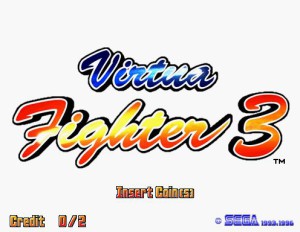 Virtua Fighter 3 released to arcades in 1996 to the Sega Model 3 Step 1.0 arcade hardware, making it one of the first games to hit the system along with Scud Race. Virtua Fighter 3 adds two new characters to the previous games roster, introducing players to Aoi Umenokoji and Taka-Arashi. Also, as is now custom with Virtua Fighter sequels, graphical and audio improvements were made to the game. However the usual improvements weren’t all that the third game added, as new innovations such as multi-level play areas and a dodge button made their series debut.
Virtua Fighter 3 released to arcades in 1996 to the Sega Model 3 Step 1.0 arcade hardware, making it one of the first games to hit the system along with Scud Race. Virtua Fighter 3 adds two new characters to the previous games roster, introducing players to Aoi Umenokoji and Taka-Arashi. Also, as is now custom with Virtua Fighter sequels, graphical and audio improvements were made to the game. However the usual improvements weren’t all that the third game added, as new innovations such as multi-level play areas and a dodge button made their series debut.
While a Saturn port was in the works, complete with a trailer which was released in 1996, no gameplay footage ever emerged. There were plans for a Saturn 3D accelerator which would plug into the system’s cartridge port, allowing for a port of the game that better resembled the arcade release, but eventually development shifted to SEGA’s Dreamcast.
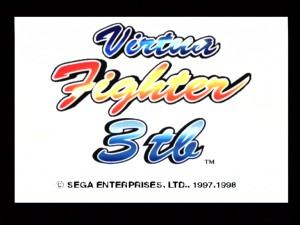 Virtua Fighter 3tb was the long-awaited console release of Virtua Fighter 3, and with such a long time between the arcade original and the console port, came a number of new features. Originally released to arcades as an update, Virtua Fighter 3tb adds “team battles” to the mix (hence tb), allowing players to fight in turns against other teams. Released as a Dreamcast launch title in Japan and Europe, and despite being long awaited, it was not met with the same acclaim as past titles. This may be due to the fact the port was handled by Genki (developers of Tokyo Xtreme Racer) and not AM2, who were busy on other projects at the time, or by the fact it may have been rushed out as a launch title. Another reason may be that the additions of team battles and multi-tiered stages were too much for fans of the series, which may explain why such innovations did not appear in the next release.
Virtua Fighter 3tb was the long-awaited console release of Virtua Fighter 3, and with such a long time between the arcade original and the console port, came a number of new features. Originally released to arcades as an update, Virtua Fighter 3tb adds “team battles” to the mix (hence tb), allowing players to fight in turns against other teams. Released as a Dreamcast launch title in Japan and Europe, and despite being long awaited, it was not met with the same acclaim as past titles. This may be due to the fact the port was handled by Genki (developers of Tokyo Xtreme Racer) and not AM2, who were busy on other projects at the time, or by the fact it may have been rushed out as a launch title. Another reason may be that the additions of team battles and multi-tiered stages were too much for fans of the series, which may explain why such innovations did not appear in the next release.
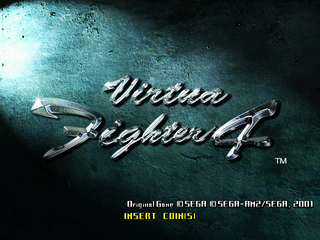 Released to arcades in 2001 and running on Sega NAOMI 2 hardware, Virtua Fighter 4 was the first sequel to truly feel like the series has stepped into the next generation. From the game’s title screen, which traded the white background and colorful logo for a darker and grittier look, to the graphics which were not just a minor improvement from the last game. Now, characters looked almost lifelike, and environments were filled with amazing details.
Released to arcades in 2001 and running on Sega NAOMI 2 hardware, Virtua Fighter 4 was the first sequel to truly feel like the series has stepped into the next generation. From the game’s title screen, which traded the white background and colorful logo for a darker and grittier look, to the graphics which were not just a minor improvement from the last game. Now, characters looked almost lifelike, and environments were filled with amazing details.
The tradition of new characters continued with the addition of Lei-Fei and Vanessa Lewis, and like past Virtua Fighter games, Virtua Fighter 4 saw several upgrades during its lifespan – Ver. B and Ver. C. The game also saw two major upgrades, Virtua Fighter 4: Evolution and Virtua Fighter 4 Final Tuned. Virtua Fighter 4 was the first game in the series to be released after SEGA left the home console market, meaning Playstation 2, Xbox, and Nintendo’s Gamecube were candidates for a home console port. As SEGA entered the third party realm, it was made clear that certain consoles catered to certain markets, and as such fans of AM2 and SEGA arcade ports would have to look to the Playstation 2 for such games. Virtua Fighter 4 released to the Playstation 2 in 2002, and while just as fun as the arcade release, some – like myself – couldn’t get past the jaggy graphics.
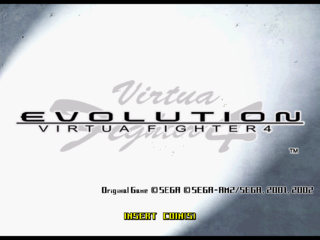 Virtua Fighter 4 Evolution, released to arcades as a major upgrade in 2002, saw release on the Playstation 2 in 2003 – making it the first Virtua Fighter game since the original to see an upgrade released to the same home console after the original also saw release. The upgrade features two new characters, the Judoka-assassin, Goh Hinogami and the Muay Thai boxer, Brad Burns. Stages were adjusted, taking place at a different times of day in comparison to the original release. Playstation 2 owners also saw improved graphics, including less noticeable jaggies, and the inclusion of Virtua Fighter 10th Anniversary. Virtua Fighter 10th Anniversary celebrated the series’ 10th anniversary with a “demake” of Virtua Fighter 4 Evolution, featuring characters with low polygon models, reduced movesets, and floaty physics which resemble the first title of the series.
Virtua Fighter 4 Evolution, released to arcades as a major upgrade in 2002, saw release on the Playstation 2 in 2003 – making it the first Virtua Fighter game since the original to see an upgrade released to the same home console after the original also saw release. The upgrade features two new characters, the Judoka-assassin, Goh Hinogami and the Muay Thai boxer, Brad Burns. Stages were adjusted, taking place at a different times of day in comparison to the original release. Playstation 2 owners also saw improved graphics, including less noticeable jaggies, and the inclusion of Virtua Fighter 10th Anniversary. Virtua Fighter 10th Anniversary celebrated the series’ 10th anniversary with a “demake” of Virtua Fighter 4 Evolution, featuring characters with low polygon models, reduced movesets, and floaty physics which resemble the first title of the series.
The second major update to the fourth game released to arcades in 2004 under the name Virtua Fighter 4 Final Tuned. Not released to home consoles, Virtua Fighter 4 Final Tuned featured new moves and stage changes as well as more online functionality.
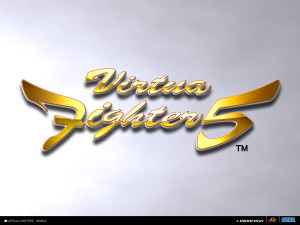 Virtua Fighter 5 is the latest and longest running Virtua Fighter sequel. Released to arcades on the Sega Lindbergh arcade platform in 2006, and to the Xbox 360 and Playstation 3 in 2007, with the Xbox 360 port being similar to the arcade’s version C revision and the PS3 port being the version B revision. New characters included Eileen and El Blaze, and later updates saw the return of Taka-Arashi, who hadn’t been seen since his debut in Virtua Fighter 3, and the new addition of Jean Kujo. The game features the addition of the Clash System, which when executed with the right timing, an attack can be cancelled with a throw. This was contrary to the previous game’s system in which attacks always beat throws. The Xbox 360 release introduced online support, a feature lacking from the PS3 version.
Virtua Fighter 5 is the latest and longest running Virtua Fighter sequel. Released to arcades on the Sega Lindbergh arcade platform in 2006, and to the Xbox 360 and Playstation 3 in 2007, with the Xbox 360 port being similar to the arcade’s version C revision and the PS3 port being the version B revision. New characters included Eileen and El Blaze, and later updates saw the return of Taka-Arashi, who hadn’t been seen since his debut in Virtua Fighter 3, and the new addition of Jean Kujo. The game features the addition of the Clash System, which when executed with the right timing, an attack can be cancelled with a throw. This was contrary to the previous game’s system in which attacks always beat throws. The Xbox 360 release introduced online support, a feature lacking from the PS3 version.
Like Virtua Fighter 4, 5 saw two major arcade updates, one of which released to home consoles. Virtua Fighter 5 R was an arcade only update released in 2008, which brought new stages and characters, bringing the fighter count up to twenty. A fun addition the update brought was the ability to customize fighters to resemble classic SEGA characters, such as an Ulala costume for Sarah and a Samba de Amigo costume for El Blaze. Sadly, no Ryo Hazuki costume for Akira, though fans have tried their best with the available costumes.
 Virtua Fighter 5: Final Showdown is the latest, final, and most recent version of Virtua Fighter to exist. Released to arcades in 2010 and released to PSN and XBLA as a title separate from the original Virtua Fighter 5 in 2012, Final Showdown features new stages, costumes, and animations. While the arcade version retained the Virtua Fighter 5 R stages, the home console release has only the new Final Showdown stages. However, the home port of the game includes a tutorial mode, online play, and soundtracks from previous games in the series.
Virtua Fighter 5: Final Showdown is the latest, final, and most recent version of Virtua Fighter to exist. Released to arcades in 2010 and released to PSN and XBLA as a title separate from the original Virtua Fighter 5 in 2012, Final Showdown features new stages, costumes, and animations. While the arcade version retained the Virtua Fighter 5 R stages, the home console release has only the new Final Showdown stages. However, the home port of the game includes a tutorial mode, online play, and soundtracks from previous games in the series.
Day One! Ready, GO!
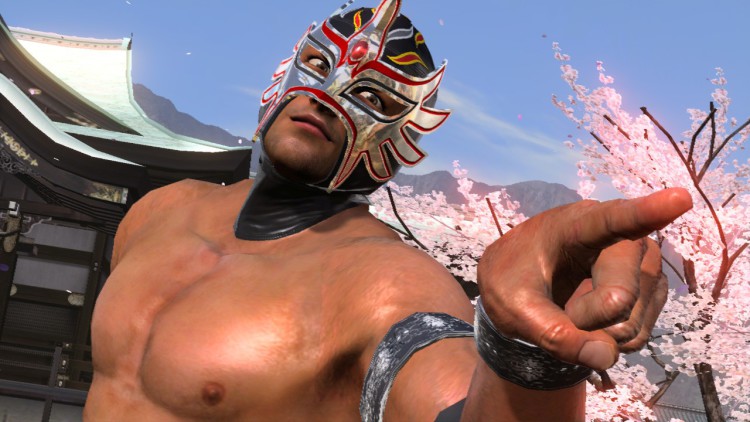
As evidenced, though only five games, the Virtua Fighter has seen a great deal of improvements and innovations over the past twenty-two years. With deceptively simple controls and a focus on pure fighting, the series remains the grandfather of 3D fighters and a series that all 3D fighters owe a debt of gratitude. Throughout Virtua Fighter Week, we plan to look back at what made the series as great as it is, and look forward at what is (hopefully) to come. We’ll shine the spotlight on the gameplay, music, and the strange and interesting places SEGA toogek the characters, and even take a look at the off-the-wall spinoff titles.
What are you waiting for? Select your player, press the start button, and enter the ring – Virtua Fighter Week begins now! Ready, GO!
Ad:
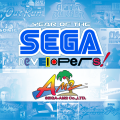

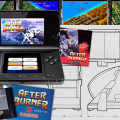
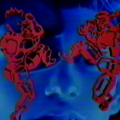

“Better run home to mamma now!”
I remember hissing when VF4 became exclusive to PS2. I hadn’t really played the series after VF2, but the fact that I couldn’t have it kept me away until VF5:FS.
I remember when SEGA announced that certain devs would work on certain consoles, and was very upset to see AM2 go to PS2. Especially when I had bought an Xbox already, so I sort of swore allegiance to that instead. Though I ended up getting a PS2 soon after and picked up VF4: Evolution, but I couldn’t get into it like I got into VF2. Must have been the fanboy in me.
I remember hearing Yu Suzuki saying that it was originally to be a Dreamcast project and that’s how he wanted it, being on the Noami arcade console series, it had a lot more in common with the Dreamcast than it did on the PS2, but Sega management then, didn’t green light it for the Dreamcast as Sega had obviously announced their March 2001 restructure by then and it wasn’t considered a viable business decision, especially with their financial health then.
Yu Suzuki did still want to dedicate something VF4 related for the Dreamcast though regardless, and that was included with the Ltd edition of Shenmue II.
I wish Virtua Fighter 4 was given a PC release, or a release on modern consoles. I know it’s considered “outdated” thanks to VF5, but it would be nice to see it on a platform other than PS2. Though arcade emulators seem to do a decent job with it: https://www.youtube.com/watch?v=lFfa1qyCMhQ